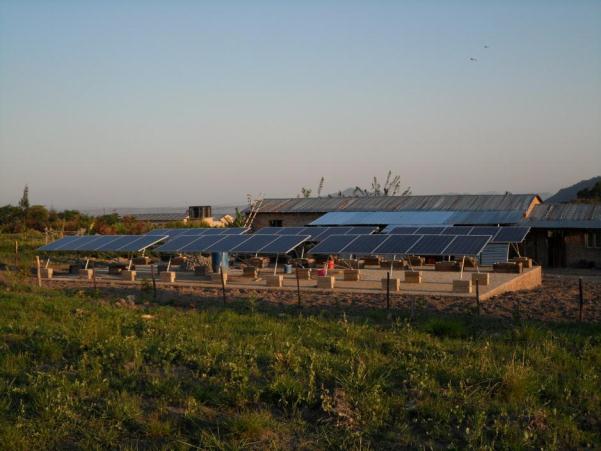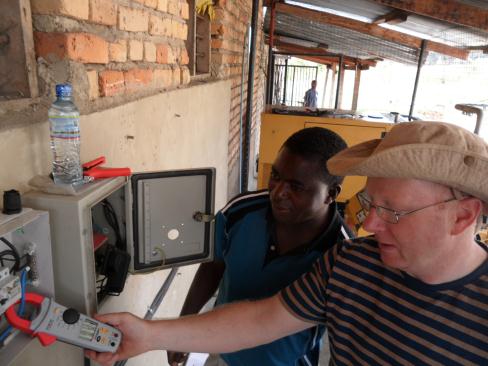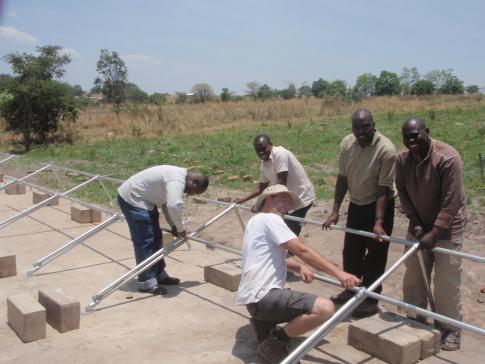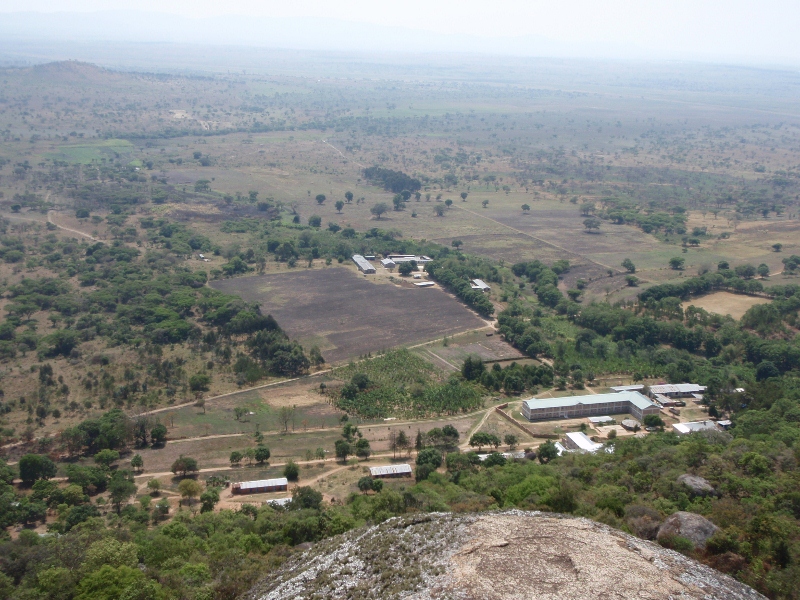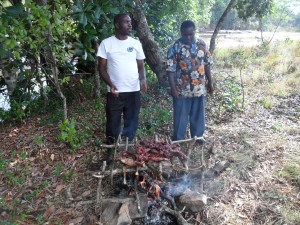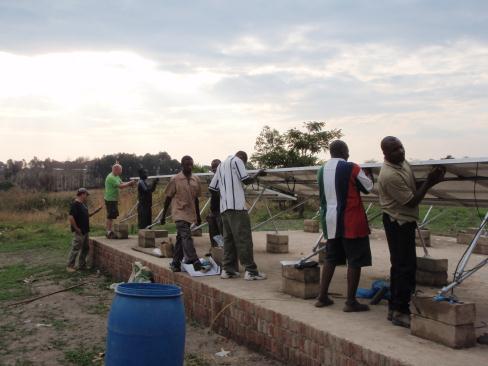 In early October 2012, Sean Coomey and Xavier Dubuisson travelled to Tanzania from Ireland to install a solar power system at a primary school part of the Mvimwa Benedictine Abbey. The project was an international co-operation between Solar Without Frontiers (Ireland), Glenstal Abbey (Ireland), St Ottilien Archabbey (Germany) and the Mvimwa Abbey (Tanzania). SWF is an Irish NGO dedicated to supporting African communities with solar energy. The two SWF volunteers, undertook the technical delivery of the project, from concept stage to design, procurement, installation and commissioning. On Saturday 6th of October evening, the lights went on at the school without the background noise of the generator – to everybody’s amazement. The following posts will relate the project implementation and unique experience this has been for the Irish-Tanzanian team involved.
In early October 2012, Sean Coomey and Xavier Dubuisson travelled to Tanzania from Ireland to install a solar power system at a primary school part of the Mvimwa Benedictine Abbey. The project was an international co-operation between Solar Without Frontiers (Ireland), Glenstal Abbey (Ireland), St Ottilien Archabbey (Germany) and the Mvimwa Abbey (Tanzania). SWF is an Irish NGO dedicated to supporting African communities with solar energy. The two SWF volunteers, undertook the technical delivery of the project, from concept stage to design, procurement, installation and commissioning. On Saturday 6th of October evening, the lights went on at the school without the background noise of the generator – to everybody’s amazement. The following posts will relate the project implementation and unique experience this has been for the Irish-Tanzanian team involved.
Mvimwa school hosts a kindergarten and primary school with approximately 470 pupils, aged between 4 and 13 years old. The school caters for local villages and boarders from all over the region. It is recognised as a centre of excellence in education, and is one of several primary and secondary schools operated by the Benedictine Order in Tanzania. Mvimwa, a beautiful rural and remote area, is located about 60 km north-west of the district town of Sumbawanga, between Lake Rukwa and Lake Tanganyika.
The overall objective of the project was to help improve the educational facilities and the well-being of the children at Mvimwa by increasing the electricity supply to the school via the installation of a solar photovoltaic (PV) energy system. The school being off the grid, it was relying on a diesel generator for its electricity supply. However, diesel is very expensive and must be transported by road over long distances, resulting in electricity supply being limited to 2 hours a day prior to the solar system installation. This imposed significant restrictions for the use of the school’s computer room and the provision of other commodities we in the West take for granted such as lighting (it’s dark at 6.30 pm in Tanzania), refrigeration, communication, radios, TVs, etc.
The drawing below is a single-line diagram of the off-grid solar PV system installed at Mvimwa. The solar array is made of 30 poly-crystalline panels (REC Peak Energy Series 245W) and has a total capacity of 7.35 kW peak, ground mounted with an inclination of 15 degrees and facing North (!). The Direct Current (DC) produced by the array is converted to Alternating Current (AC) by the inverter (SMA Mini Central 7000HV). The Sunny Island 5048 (SMA) is a bidirectional inverter and charger i.e. it converts AC current from the solar PV system into DC current to charge the batteries (8 x Rolls 6 CS 25P), and when the electricity demand requires it (at night typically) converts the DC current stored in the batteries back into AC.
When the batteries are too discharged to continue supplying the electrical loads, the Sunny Island turns on the generator (13 kVA Olympian GEP 11SP4 supplied by Finning UK & Ireland in Dublin) to meet the loads and recharge the batteries. An Interface panel was supplied and pre-assembled in Ireland free of charge by ASC controls in Lissarda Co Cork. The function of the interface panel is to provide an AC connection point for all components of the system and to provide change-over functionality for the generator. The PV panels, mounting system, inverters and batteries were procured from Wind & Sun Ltd (UK), who were very generous with their technical assistance, and represents state-of-the-art in off-grid solar technology.
The system was designed on the basis of a detailed analysis of the existing and projected electrical loads at the school and sized in order to provide most of the electricity demand on an average day under the constraints of the available budget. The battery bank can store 30 kWh and provide one day of autonomy when fully charged. A simulation of the operation of the system with the software RETScreen indicates that the solar installation should deliver 10,500 kWh per year, or 85% of the total predicted electricity usage. According to the online simulation tool PV-GIS, the average annual solar irradiation received by the solar array is 2200 kWh/m2, using Sumbawanga as reference location. This is twice the amount of solar energy available in West Cork, Ireland.

The 1250 km journey took approximately 24 hours of driving across magnificent Tanzanian landscapes of plains, plateaux, mountains, natural reserves, villages and towns. Hard on our tired bodies but fascinating introduction to the country and its people.
After making its way to Tanzania, and weeks of arduous negotiations by Brother Max to get the container out of Dar es Salaam Port, the solar equipment was eventually delivered by truck to Mvimwa. Safe in the knowledge that the equipment had arrived without apparent damage, everything went quickly for the Irish team – flights were booked, final preparations made and suitcases packed. Xavier and Sean arrived late in Dar es Salaam via Amsterdam on Sunday 30 September, where they were welcomed by Bro Max and joined by Rick Coe, a marine engineer originally from Zimbabwe and solar enthusiast who volunteered to come and help us with the installation. The next morning, we left with a VW van and a crew of 8 for a long 2-day road trip across the country via Morogoro, Iringa, Rujewa, Mbeya, Tunduma, Sumbawanga and finally Mvimwa.
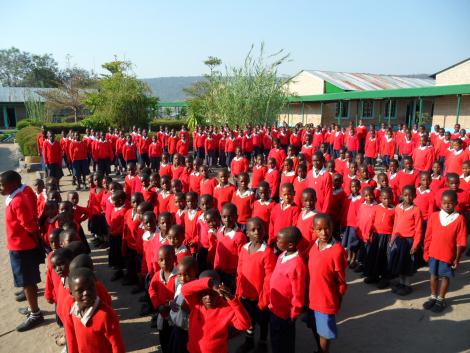
Day one - We were greeted by a beautiful rendition of Mungu ibariki Afrika, the national anthem, before setting off to work
By Wednesday morning, we were on site, welcomed and introduced to the school community by a beautiful rendition of the national anthem by the pupils and a lovely speech by the principal, Brother Beatus. After a quick tour of the school, we started work. The volunteers were joined by a dedicated group of helpers from the Abbey, the school and the nearby village. Two teams were set up, one concentrating on the solar array installation and the other on the electrical works – with several contractors (referred to as ‘fundis’ in Kiswahili) doing civil works around the installation.
We tried to maximise the training opportunity for everybody by rotating people between jobs according to their interests and abilities, and taking our time to explain what was happening. Bro Edgar (trainee electrician) and Bro Matias (qualified electrician and facility manager at the abbey) worked closely with Sean (electrical engineer) on installing the batteries, inverters and other power system elements. They were also trained specifically for ongoing maintenance work. It transpired very quickly that we had a very skilled and eager team, and the pace and quality of work was excellent. It should also be pointed out that a lot of work went on before the volunteers arrived to set up the solar array plinth and build the plant room.
The existing 3-phase generator was deemed to be highly oversized and running inefficiently. It was replaced by the new single-phase generator and will be put to better use at the Abbey. The existing control panel was found to be deficient and was also replaced by a brand new interface panel. Thanks to Sean and his collaborators, the electrical installation was made to be the best industrial standards and under the best health and safety conditions possible.
By the first night, the mounting frames were largely assembled and 50% of the solar modules installed. When we realised that there had been a misunderstanding on the size of the concrete blocks used for ballast, a solution was quickly found to retrofit them without delaying the solar array installation. We know now that it would have been more efficient to cast concrete pads directly into the plinth (or the ground) and we’ll take that as a lesson learned for the next project. We found the SKT-type mounting frame system from BDS very robust, flexible and relatively easy to install. After a few trial and errors, we had a good routine in place – a very different approach than the manufacturer’s instructions but nevertheless very effective.
By Friday night, we were ready to turn on the solar system. Everybody was on full alert and anticipation, waiting for the moment of truth. On Saturday morning, we switched on the system and it was cries of relief and joy all around! We spent the rest of the day commissioning the system and going through the operating instructions with Bro Matias.
After a beautiful day of solar power, the batteries were fully charged and ready to service the school at nightfall. It was a great delight to see the school literally glowing in the dark – and silence in the generator room! It was time to enjoy the cold beers – another first at the school –which we had put in the fridge during the afternoon in anticipation of our celebration.
On Sunday, we had a wonderful experience attending Mass at the Abbey with beautiful singing by the lively choir, and emotional speeches by Bro Max and the volunteers – acknowledging the bond created by the rich experience of working together for the benefit of the school community. We were then treated to a full tour of the Abbey, its hospital, its farm, and vocational training facilities. We were fascinated by the anaerobic digestion system producing biogas for cooking with cattle and pig dung and other organic waste. The Abbey also uses hydropower to cover part of its electricity supply during the rainy season. We also took a walk to the top the hill from where we savoured impressive views of the region. There was a lovely breeze up there that got us thinking about a small-scale wind project!
The solar team, joined by a few school teachers and monks, then went off for a barbecue in the bush, beside the impressive waterfalls of the Matalani River. We were finally able to relax in good company, with the help of roasted goat meat, beer and a bottle of Irish whiskey. The knowledge that we were in a Game Reserve (with traces of elephants and lions all around) added some thrill to the proceedings – although the presence of a local armed guard gave us some peace of mind.
The benefits of the solar project in Mvimwa:
For the school community:
- One of the primary objectives of the project was to enable a more extensive use of the computer room set up by Irish NGO Camara in 2010, previously limited to 2 hours a day when the generator is on. With solar electricity on, computers can be on during the day and allow kids much more learning time on them – with a direct benefit for computer literacy. Combined with internet access, this opens a virtual access to the world for the school and a broad range of educational opportunities.
- Teachers will now be able to print, photocopy and use computers during daytime too, removing the burden of night time use. It also means that workers will have more and better lighting to carry out activities such as cooking, baking, cleaning, etc. when it suits them. Generally, the greater availability of electricity will help the school to work more efficiently.
- The safety and wellbeing of children at night will improved by having better lighting of dormitories and circulation areas. Solar light will also remove the cost of kerosene and batteries currently used for night lights.
For the management of the school:
- The solar PV should cover most (>90%) of the electricity supply, displacing inefficient diesel generators. It is estimated that the project will result in an annual saving in diesel of €3700 (not counting the time of the weekly 5-hour journey to Sumbawanga, and wear and tear on the van, for collecting the fuel). These savings can be reinvested elsewhere in the school and open new opportunities. And all this with much more electricity being available.
- Another direct financial benefit is that solar energy removes the vagaries of fuel price variation and the impact it has on school management. When the price of fuel went up, as it does, it created serious difficulties for balancing the school budget. Similarly, the generator maintenance service and spare parts had to be paid in dollars, creating vulnerability to changes in exchange rates.
- Daytime access to internet and other communication facilities (faxes, etc.) will make life much easier for the school staff but also for people at the Abbey.
- Cold drinks won’t be such a luxury anymore and make celebrations and reunion with parents that bit more enjoyable…
For the solar project team:
- One of the key outcomes of the project implementation was the training opportunity it afforded to the team. The heads-down hands-on experience of installing the solar system was new for most involved. The availability of trained and experienced technicians on site will be a strong guarantee that the solar system will be looked after properly in the future. These skills can be built on for future solar projects in the region.
- This was a human experience of discovery for the Solar Without Frontiers volunteers, made so unique by the caring and friendly attention received from the Mvimwa Abbey and School communities. It also helped increase the volunteers’ know-how and confidence in undertaking other solar projects in the future.
- For the Benedictine communities of Glenstal Abbey and St Ottilien Archabbey in Germany, as well as the many individual or corporate donors, it is the reassurance that their gifts will make a real, durable difference for the Mvimwa school and its pupils.
- It is also hoped that this experience will inspire others in promoting and using solar technology for the sustainable socio-economic development of their community. This is particularly true in Africa where access to electricity is such an acute issue for health, education and economic development. But solar energy is equally valid in Ireland and the rest of the ‘industrialised world’ where breaking our dependence to fossil fuels is an imperative.
